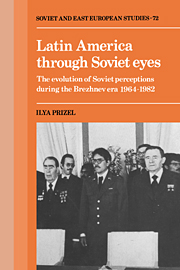 Latin America through Soviet Eyes
Latin America through Soviet Eyes Book contents
- Frontmatter
- Contents
- Preface
- Acknowledgments
- Introduction
- Part I Soviet perceptions of Latin America's global role
- Introduction
- 1 Soviet perceptions of US–Latin American relations
- 2 Latin America's role in the capitalist division of labor
- 3 Latin America's role in the Third World
- 4 Soviet views on Latin America's regional integration
- 5 Soviet conclusions regarding Latin America's ability to conduct an independent foreign policy
- Part II Soviet perceptions of Latin American social structures
- Part III Soviet–Latin American relations during the Brezhnev era
- Part IV Conclusion: the emerging Soviet perception of Latin America and the future of Soviet policy toward the hemisphere
- Conclusions
- Epilogue – Latin America: the Long March
- Notes
- Bibliography
- Index
4 - Soviet views on Latin America's regional integration
Published online by Cambridge University Press: 05 February 2012
- Frontmatter
- Contents
- Preface
- Acknowledgments
- Introduction
- Part I Soviet perceptions of Latin America's global role
- Introduction
- 1 Soviet perceptions of US–Latin American relations
- 2 Latin America's role in the capitalist division of labor
- 3 Latin America's role in the Third World
- 4 Soviet views on Latin America's regional integration
- 5 Soviet conclusions regarding Latin America's ability to conduct an independent foreign policy
- Part II Soviet perceptions of Latin American social structures
- Part III Soviet–Latin American relations during the Brezhnev era
- Part IV Conclusion: the emerging Soviet perception of Latin America and the future of Soviet policy toward the hemisphere
- Conclusions
- Epilogue – Latin America: the Long March
- Notes
- Bibliography
- Index
Summary
The idea of Latin American unity is as old as the region's independence. Latin America's founding fathers, especially Bolívar, envisaged either one huge Spanish-speaking state, stretching from Mexico to Argentina, or an alternative of no more than three states. Although Bolívar's dream failed to materialize, and the four viceroyalties of Spanish America fragmented into eighteen separate states, the idea of unity has nevertheless continued to evoke a response throughout Latin America.
During the nineteenth century, the Latin American states periodically revived the idea of regional unity when they perceived a threat of foreign aggression. Four congresses were called in response to, for example, fears that Spain might attempt to reintroduce colonialism in the hemisphere. The absence of concrete results at these conferences, and of exterior threats to the territorial integrity of the Latin American states after 1865, resulted in declining interest in political unity.
Unlike the idea of political unity, the notion of economic unity did not emerge until after World War II. The lack of economic intercourse within Latin America can be attributed in part to the continent's vast physical scale and the impassable terrain separating different areas. Furthermore, the region's infrastructure obstructed the development of inter-Latin American trade, since any economic development that had occurred was designed to serve a specific foreign market – usually European or North American.
A basis was laid for expanding trade among the region's republics when several larger states undertook an “export substitution” policy during the Great Depression.
- Type
- Chapter
- Information
- Latin America through Soviet EyesThe Evolution of Soviet Perceptions during the Brezhnev Era 1964–1982, pp. 53 - 62Publisher: Cambridge University PressPrint publication year: 1990
